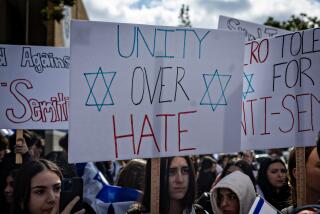Hate-crime case witnesses called heroes
- Share via
Presenting her closing argument Wednesday in the Long Beach hate-crime case, the prosecutor called two of her witnesses heroes for coming forward, and choked up while speaking of their integrity and “simple acts of kindness.”
Deputy Dist. Atty. Andrea Bouas urged Judge Gibson Lee to rely on her star witness, Kiana Alford, whose testimony is all that links six of the black youths on trial directly to the mob beating of three white women on Halloween night.
“She was very specific about what each of these children did,” Bouas said. “She made a distinction between throwing a newspaper and throwing a pumpkin.”
The nine girls and one male -- ages 12 to 18 -- on trial are charged with assault with intent to cause great bodily injury. Eight are charged with a hate-crime enhancement, because racial slurs were allegedly shouted during the attack.
The proceedings moved with unusual efficiency for what has been a fractious and at times plodding trial that began Nov. 28. The prosecution finished its closing, and two defense attorneys finished theirs.
Bouas will have a rebuttal when all 10 defense attorneys have spoken.
On Wednesday, she laid out evidence against each defendant, including a victim’s cellphone found in one of the youths’ cars, and blood on one of the defendants’ pants.
Bouas stridently dismissed characterizations of the incident -- in some testimony -- as a fight, with the three women returning punches. She insisted that they were beaten.
“That is the understatement of the century,” she said. “This is a mauling.”
Several times Bouas used pop culture analogies in her argument -- a common technique for helping juries with arcane or complicated subjects. But in this trial, as in all juvenile trials, the judge will decide guilt or innocence.
Bouas made reference to a Phil Collins song to describe a defendant’s testimony as “a pack of lies,” a Barbara Walters TV special on heaven to describe Alford’s integrity and an Oprah special on miracles to describe the behavior of a reputed good Samaritan, Marice Huff, who testified that he broke up the assault.
“Because if this had gone on further ... one more punch, there goes the spleen, there goes the kidney. Doctors couldn’t put Humpty Dumpty back together again,” she said.
Tom Harmon made the first closing argument for the defense, saying that his client -- a girl who turned 12 the night before Halloween -- was innocent.
Bouas had called her an instigator because she was allegedly part of the crowd throwing fruit and newspapers at the victims before the attack.
“She is responsible for all that follows,” Bouas said. “You can’t just start it and say, ‘Gee, it was not my fault.’ It doesn’t work that way.”
The evidence against the girl is clearly the thinnest of the 10, and she is not charged with the hate-crime enhancement.
Harmon said the case is based on a single statement Alford made to police, when the suspects were shown one-by-one to her and the victims in a parking lot where the youths were detained. “She was throwing newspapers around at the girls,” Alford said, according to a police report.
“It’s a one-sentence case,” said Harmon. The attorney noted that the prosecutor had stipulated that Alford was parked 300 feet away when she saw his client.
“It’s absolutely impossible for her to have seen what she claims to have seen,” he said. “That’s the distance of a football field, at nighttime.”
Harmon noted that the friend who was with Alford that night, Lineshia Hill, testified that they were parked 600 feet away, at the other end of the block. Hill said they came upon the victims after the attack and did not see the beatings.
He also noted that calls to 911 described male assailants.
“Where are they?” he said. “Are they here in court? They are out in the street.”
These minors are what the prosecution “case is based on because they didn’t catch the people who did it,” he said.
In his closing, attorney John Schmocker said his client, a 16-year-old girl, is was also tied to the attack by a single statement -- this one from victim Loren Hyman, 21, identifying the girl as one of her attackers. “She was on my right side,” Hyman told police.
Schmocker said Hyman and the other witnesses were not asked to describe the culprits before they were shown the suspects. Experts say that having a prior description from a witness that matches the appearance of a suspect significantly bolsters the field identifications.
Schmocker said Hyman had been drinking that night, that her eye was injured and she was stressed. And he said that cross-racial identifications are inherently difficult in the best of circumstances.
He noted that no blood was found on his client’s clothes.
My client “is innocent,” he said. “But the possibility of innocence is the concern here, because if there is a possibility, there is reasonable doubt.”
Outside the court, an attorney for the victims, Doug Otto, said the victims believed the youths on trial were the main assailants that night, despite contradictory statements that black males were responsible.
“There are some cases that are stronger than others,” he said, conceding that the “weakest case” was against the 12-year-old girl.
More to Read
Sign up for Essential California
The most important California stories and recommendations in your inbox every morning.
You may occasionally receive promotional content from the Los Angeles Times.











